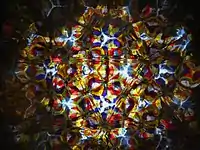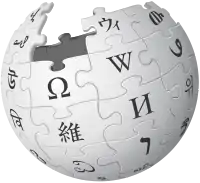kaleidoscope
See also: kaléidoscope
English
WOTD – 11 December 2022
Etymology

A toy kaleidoscope (sense 1).

Colourful patterns seen inside a kaleidoscope (sense 1).
The noun is derived from Ancient Greek καλός (kalós, “beautiful, lovely”) + εἶδος (eîdos, “form, image, shape”) + English -scope (suffix denoting an instrument used for examination or viewing), coined by the British scientist David Brewster (1781–1868) in his 1817 patent for the invention:[1] see the quotation.
The verb is derived from the noun.[2]
Pronunciation
- (Received Pronunciation) IPA(key): /kəˈlaɪdəskəʊp/
Audio (Southern England) (file) - (General American) IPA(key): /kəˈlaɪdəˌskoʊp/
- Hyphenation: kal‧ei‧do‧scope
Noun
kaleidoscope (plural kaleidoscopes)
- An instrument consisting of a tube containing mirrors and loose, colourful beads or other objects; when the tube is looked into and rotated, a succession of symmetrical designs can be seen. [from 1817]
- 1817 July 10, David Brewster, “Specification of the Patent Granted to David Brewster, of Edinburgh, Doctor of Laws; for a New Optical Instrument, Called The Kaleidoscope, for Exhibiting and Creating Beautiful Forms and Patterns, of Great Use in All the Ornamental Arts [patent no. 4136]”, in The Repertory of Arts, Manufactures, and Agriculture. […], volume XXXI (Second Series), number CLXXXVI, London: […] [Nichols, Son, and Bentley] for J. Wyatt, […], published November 1817, OCLC 638049490, page 321:
- The Kaleidoscope (from καλος beautiful, ειδος a form, and σκοπεω to see) is an instrument for creating and exhibiting an infinite variety of beautiful forms, and is constructed in such a manner as either to please the eye, by an ever-varying succession of splendid tints and symmetrical forms, or to enable the observer to render permanent such as may appear most appropriate for any of the numerous branches of the ornamental arts.
- 1824 April, [Thomas Babington] Macaulay, “Criticisms on the Principal Italian Writers. No. II. Petrarch.”, in T[homas] F[lower] E[llis], editor, The Miscellaneous Writings and Speeches of Lord Macaulay, new edition, London: Longman, Green, Reader, & Dyer, published 1871, OCLC 30956848, page 49:
- The mind of Petrarch was like a kaleidoscope. At every turn it presents us with new forms, always fantastic, occasionally beautiful; and we can scarcely believe that all these varieties have been produced by the same worthless fragments of glass.
- 2020, Noreena Hertz, “Our Screens, Our Selves”, in The Lonely Century: A Call to Reconnect, London: Hodder & Stoughton, →ISBN:
- Detractors saw the kaleidoscope as an expression of a mass consumer culture that could be all too easily distracted by the shiniest new baubles and sensations. […] The revolution that Steve Jobs triggered in 2007 with the launch of the iPhone means that most of us now have a modern day kaleidoscope in our pockets.
-
- (figuratively) A constantly changing series of colours or other things.
- 1819 July 15, [Lord Byron], Don Juan, London: […] Thomas Davison, […], OCLC 560103767, canto II, stanza XCIII, page 165:
- [T]his rainbow look'd like hope— / Quite a celestial kaleidoscope.
- 1831, L[etitia] E[lizabeth] L[andon], chapter V, in Romance and Reality. […], volume I, London: Henry Colburn and Richard Bentley, […], OCLC 24531354, pages 34-35:
- Lady Etheringhame being now a constitutionalist, dined rather early: and Emily, her head like a kaleidescope, full of colours, with not a little disdain, put on the blue silk she had thought bleu céleste, at least in the country.
- 1961 April, G. Freeman Allen, “The ‘Rheingold’ Goes via Cologne”, in Trains Illustrated, London: Ian Allan Publishing, ISSN 0141-9935, OCLC 35845948, page 231:
- The rail journey from The Hook [i.e., the Hook of Holland] to Basle is a scenic kaleidoscope, ranging from the flat terrain of the Netherlands to the high ranges of the Black Forest, from the straight Dutch waterways to the sinuous Rhine gorge, from the ocean-going shipping of canals to the busy inland traffic of the Rhine and from peaceful farmland to thriving centres of commerce.
- 2020 June 17, David Clough, “Then and Now: Trains through Crewe”, in Rail, number 907, Peterborough, Cambridgeshire: Bauer Media, ISSN 0953-4563, OCLC 999467860, page 60:
- Another most notable change concerns rolling stock liveries. Back then, corporate Rail Blue was omnipresent, whereas now there is a kaleidoscope of colours and styles.
- 2022 April 20, Mariella Rudi, “Tostitos Hint of Lime has zero lime – but it’s still the perfect chip”, in Katharine Viner, editor, The Guardian, London: Guardian News & Media, ISSN 0261-3077, OCLC 229952407, archived from the original on 2022-11-29:
- The chip smells like nothing, but tastes like a smörgåsbord that's both confusing and arousing, like Steve Buscemi. Flecks of spring green – the kind generated from radioactive waste – coat the unwieldy triangles. The seasoning is a kaleidoscope of Day-Glo dust particles that perishes under saliva and tongue.
-
Alternative forms
- caleidoscope
Derived terms
- kaleidoscopelike
- kaleidoscopic
- teleidoscope
Translations
instrument consisting of a tube containing mirrors and loose, colourful beads or other objects; when the tube is looked into and rotated, a succession of symmetrical designs can be seen
|
constantly changing series of colours or other things
|
Verb
kaleidoscope (third-person singular simple present kaleidoscopes, present participle kaleidoscoping, simple past and past participle kaleidoscoped)
- (intransitive) To move in shifting (and often attractive or colourful) patterns.
Derived terms
- kaleidoscoping (adjective, noun)
Translations
to move in shifting (and often attractive or colourful) patterns
References
- “kaleidoscope, n.”, in OED Online
 , Oxford, Oxfordshire: Oxford University Press, March 2022; “kaleidoscope, n.”, in Lexico, Dictionary.com; Oxford University Press, 2019–2022.
, Oxford, Oxfordshire: Oxford University Press, March 2022; “kaleidoscope, n.”, in Lexico, Dictionary.com; Oxford University Press, 2019–2022. - “kaleidoscope, v.”, in OED Online
 , Oxford, Oxfordshire: Oxford University Press, March 2022.
, Oxford, Oxfordshire: Oxford University Press, March 2022.
Further reading
 kaleidoscope on Wikipedia.Wikipedia
kaleidoscope on Wikipedia.Wikipedia - Douglas Harper (2001–2023), “kaleidoscope”, in Online Etymology Dictionary.